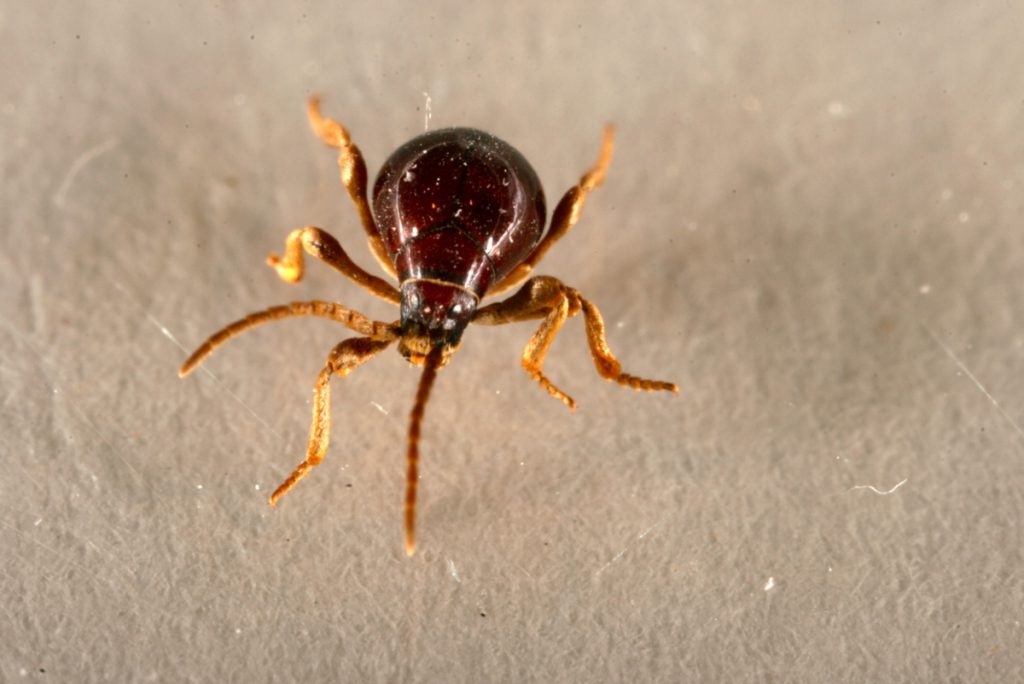SERVICE REQUEST?
Fill out the form below.
Find our nearest location
Your Local Office

Shiny Spider Beetle
Attribution: Jack Horsley of Insect.com
Size:
About 1/8 of an inch
Color:
Shiny reddish brown
Behavior:
About 30 species of spider beetles worldwide may be pests of food products. Only a few of these are found in the United States and Canada and the shiny spider beetle is one of those most commonly encountered. The female shiny spider beetle lays fewer eggs than other spider beetle species, with the life cycle taking about 10 months to complete. Pupation takes place inside the infested food product and the cocoons are spherical in shape. The adults generally live several months but have been reported to survive longer than one year. Spider beetles are mainly scavengers on plant and animal substances and are usually seen in grains infested by some other stored product beetle. They often feed on parts of dead insects within the food product. Spider beetles contaminate food products with body parts, feces and pupal cases. These beetles prefer the dark and are most active at night or continually in darkened areas. Spider beetles harbor during daylight hours inside crevices, between food packaging and other darkened areas. Activity is greatest where cooler temperatures are found. For example, activity is seen more toward the outside of an infested stack of food products rather than the interior. Spider beetle larvae will attack almost any dry food and will gnaw small holes in food packaging. Heavily infested bags of food items may be riddled with such exit holes and also become covered by the silken pupal cocoons spun by the larvae. Only a few species of spider beetles can fly and the shiny spider is not one of these. Spider beetles often feign death when disturbed by drawing their legs up to their bodies.
Shiny spider beetles can be pests in homes, warehouses, hotels, granaries, bakeries and latrines. They will feed on a variety of products like cereals, wheat, bran, stored seeds, dog biscuits, decaying animal and vegetable refuse and cayenne pepper. These beetles are also known to breed in large accumulations of pet, bird, bat and rodent feces often found in bird or bat roosts.
The control of any stored product pest involves many steps, primary of which is discovery of infested food items or other sources of infestation (e.g., food spillage accumulation). All dried food products need to be inspected for signs of infestation. Areas where rodent, bird or bat feces may have accumulated within a structure also need to be checked. A pest management professional can be helpful in finding difficult infestation sources. · Discard infested foods in outdoor trash. Infested decorations (flowers, wreaths, etc.) should also be discarded. · Clean up and remove infested accumulations of animal feces using accepted safety precautions. Bird and bat feces are known sources of many pathogenic organisms including histoplasmosis and cyrptococcosis. Where deer mice may be present in a building, the mouse feces have been known to harbor infectious strains of hantavirus. A company qualified in remediation of animal feces accumulation should be consulted for such situations. · Clean cabinets and shelves where infested foods are stored by vacuuming and by using soap and water. · Store all dried food goods, including dried pet foods and birdseed, in a glass or plastic container with a tight lid. If beetles are in that food product then the infestation will be contained and not spread to other foods. · Consume older food products prior to newer purchases of the same food. Products purchased in larger quantities (e.g., from a wholesale food warehouse) are more likely to become an infestation source if these are stored for long periods of time – especially if they are not stored in containers with tight-fitting lids.
Family Name:
Gibbium psylloides
Read What Our Clients
Are Saying
My Terminix tech Scott is the best! He is professional, courteous and absolutely thorough about his job. Thank you for sending such a blessed tech to my house. Hamlet, NC
This letter is to say how pleased we are here at Morreene West Apartments with your services. We are very pleased with the technician, Christopher. He does a great job. Durham, NC
Terminix has consistently offered our apartment complex reliable, competent service. We are completely satisfied with their knowledgeable representative who is always punctual and does a superior job for us every time. Chapel Hill, NC
I would like to take the time to thank you for giving us such great service here at Carver Pond Apartments. Your Pest Technician Christopher Mitchell has provided us with excellent service over the last few months. Christopher is such a great help to us in providing helpful information so that we can better serve our residents here at Carver Pond. Durham, NC
SERVICE REQUEST?
Fill out the form below.